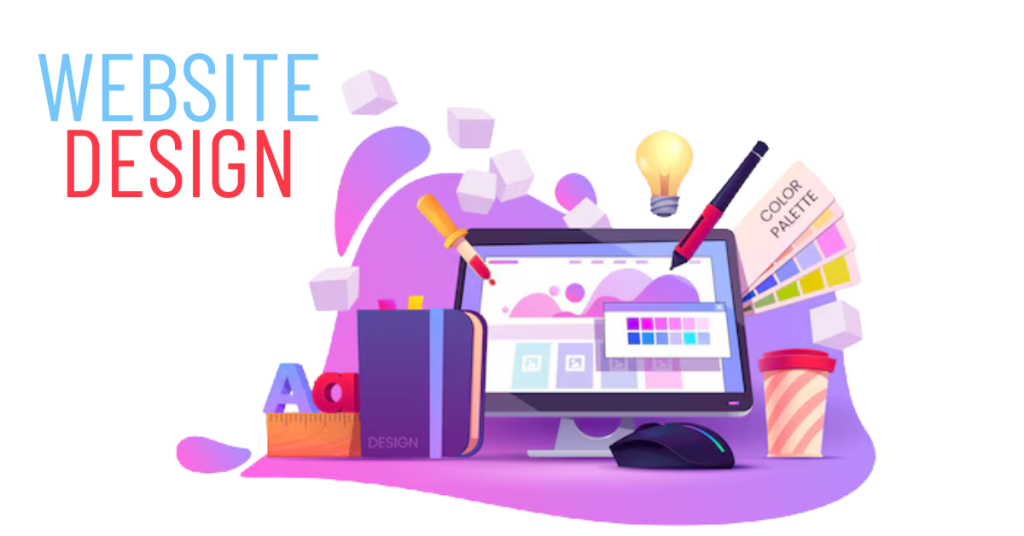In today’s digital world, a website is the face of your business, brand, or personal project. Whether you’re an entrepreneur, a small business owner, or just someone trying to make their mark online, understanding the principles of website design is essential. A well-designed website can help you build trust with your visitors, enhance user experience, and improve conversion rates. In this comprehensive guide, we’ll dive into the fundamentals of website design, key trends for 2025, and the best practices you should follow to create a visually appealing, user-friendly, and effective website.
What Is Website Design?
Website design encompasses the planning and creation of a website’s layout, structure, color scheme, typography, images, and overall visual aesthetics. It goes beyond just making the site look good; it also involves ensuring the site is functional, user-friendly, and optimized for performance. A successful website design focuses on a combination of form (visual elements) and function (how well the site works), providing an engaging experience for visitors.
Why Is Website Design Important?
A great website design has several benefits:
- First Impressions Matter: Studies show that users make a judgment about a website within the first few seconds of visiting. A visually appealing, clean design will keep visitors on your site longer.
- User Experience (UX): Good design makes it easier for users to navigate your site, find what they’re looking for, and take desired actions, whether it’s purchasing a product or filling out a contact form.
- SEO Benefits: Search engines like Google reward websites that provide a great user experience with higher rankings. A well-designed website with optimized content and a mobile-friendly interface can significantly boost your SEO efforts.
- Trust and Credibility: A professional design can inspire trust. If your website looks outdated or poorly designed, users may question the legitimacy of your brand or business.
- Conversions: The primary goal of many websites is to convert visitors into customers or leads. A design that highlights key messages, products, or services and makes it easy for users to take action (buy, contact, subscribe) can dramatically improve conversion rates.


Key Elements of Website Design
When designing a website, several key elements must be considered to ensure it’s functional, aesthetically pleasing, and optimized for performance.
1. Layout and Structure
The layout refers to the arrangement of content and elements on a webpage. A well-organized layout ensures that visitors can find what they’re looking for without feeling overwhelmed. Key considerations for layout include:
- Navigation: Ensure that the menu is simple and intuitive. Include essential pages (home, about, services, blog, contact) and ensure they’re easy to access.
- Grid System: Use a grid-based layout to create structure and harmony. Grids help align elements on the page, making it easier to design responsive websites.
- Whitespace: Don’t overcrowd the page with content. Whitespace (or negative space) is essential to give elements room to breathe, enhancing the visual appeal and readability of the page.
2. Color Scheme
Colors play a significant role in user experience and brand recognition. Choose a color palette that reflects your brand personality and conveys the right message. For example:
- Blue: Trust, professionalism, security.
- Red: Energy, passion, urgency.
- Green: Growth, health, environmental awareness.
- Black/White: Elegance, simplicity, minimalism.
Consider accessibility when choosing colors. Ensure there is enough contrast between text and background to improve readability for people with visual impairments.
3. Typography
The font you choose can have a significant impact on how users perceive your website. A good typography choice improves readability and the overall user experience. Here are some tips for typography:
- Legibility: Use fonts that are easy to read on both desktop and mobile devices. Common web-safe fonts like Arial, Helvetica, and Georgia are good choices.
- Font Hierarchy: Establish a hierarchy by varying font sizes for headings, subheadings, and body text. This helps users quickly scan the page and find relevant information.
- Consistency: Use a limited number of fonts across the site. Too many fonts can make the design look chaotic.
4. Images and Visual Elements
Visuals play an essential role in web design. High-quality images, illustrations, and videos can help convey your message, evoke emotions, and create a lasting impression. Here’s what to keep in mind:
- Quality Over Quantity: Use high-resolution images, but be mindful of the file size. Large images can slow down your website’s loading time.
- Relevance: Ensure that your images align with the content and reflect your brand’s personality.
- Alt Text: Use descriptive alt text for all images to improve accessibility and SEO.
5. Responsiveness
With the growing use of mobile devices, it’s essential to ensure that your website is responsive, meaning it looks good and functions properly on all screen sizes, from desktop monitors to smartphones.
Responsive design uses fluid grids, flexible images, and media queries to adapt the layout based on the user’s screen size. Google also rewards mobile-friendly websites with higher rankings, making responsiveness crucial for SEO.
6. Page Speed
Page speed is a critical factor in user experience and SEO. Slow-loading websites drive visitors away and can harm your search engine rankings. To improve page speed:
- Compress Images: Use tools like TinyPNG or ImageOptim to reduce image file sizes without compromising quality.
- Minimize HTTP Requests: Reduce the number of elements on a page, such as scripts, images, and stylesheets.
- Leverage Browser Caching: Set up caching so that returning visitors don’t have to reload all the page elements.
- Use Content Delivery Networks (CDNs): CDNs distribute website content across different servers worldwide, speeding up load times for users no matter their location.
7. SEO Best Practices
Website design plays a crucial role in search engine optimization (SEO). Here are a few design-related SEO best practices to keep in mind:
- Mobile Optimization: As mentioned earlier, responsive websites are essential for SEO. Google prioritizes mobile-friendly websites in its rankings.
- Structured Data: Implement schema markup to help search engines understand your content better and display rich snippets in search results.
- URL Structure: Use clean and descriptive URLs. Avoid long strings of numbers or symbols.
- Internal Linking: Link to relevant pages within your site to improve navigation and help search engines crawl your website more effectively.
Website Design Trends for 2025
As technology and user preferences evolve, so does website design. Here are some emerging trends to watch for in 2025:
- Minimalism and Clean Design: Simple, uncluttered websites with lots of whitespace continue to be popular. Minimalism allows users to focus on the most important content without distractions.
- Dark Mode: Dark mode has gained popularity for its sleek, modern appearance and ability to reduce eye strain. Offering users the option to toggle between light and dark mode can enhance their experience.
- Microinteractions: Small, subtle animations or changes (such as buttons changing color when hovered over) can make the user experience feel more interactive and engaging.
- Voice User Interface (VUI): As voice search continues to grow, websites are beginning to integrate voice-controlled navigation, allowing users to interact with the site through voice commands.
- 3D and Immersive Experiences: The rise of technologies like WebGL and VR is pushing the boundaries of interactive web design. 3D visuals and immersive experiences are becoming more common in websites, particularly in e-commerce.
- AI-Powered Personalization: With AI becoming more accessible, websites can now offer personalized experiences based on user behavior, location, and preferences. AI-driven chatbots are also helping businesses engage with users in real time.
Summary
Website design is an essential component of creating a successful online presence. By focusing on user experience, mobile optimization, and SEO best practices, you can create a website that not only looks great but also functions effectively. Keep an eye on emerging trends and technologies to stay ahead of the curve in the competitive digital landscape.
If you’re looking to build a top-notch website for your business, consider Web Development Pakistan. With a team of expert designers and developers, you can ensure that your website meets all modern standards while offering seamless functionality and design. Don’t hesitate to contact us for professional web development services and take your business online to the next level.

